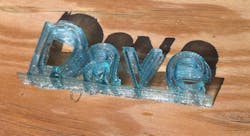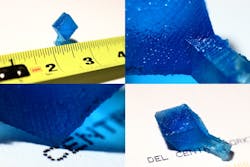Meanwhile, a dripper — another machine subsystem unique to the Peachy — meters out water to float resin and build the object’s height to specification in the Z axis.
Peachy uses software based on open-source CAD and graphic-design freeware called Blender, which allows for the creation of 3D models (as well as illustrations and even cinema-quality animations). Blender source code is available under a GNU GPL license.
Here's how the 3D printer works: Peachy software is loaded on a PC. It takes a 3D Blender model and converts it into a stream of audio waveforms. Then it plays the audio file out to the Peachy Printer through headphone jacks. The waveform drives two electromagnetic mirrors. Higher volume commands a higher voltage for more mirror movement.
In short, the mirrors reflect the photolithography laser beam to move it around the X and Y axes and selectively cure the resin to form one layer of the object at hand.
Meanwhile, in the Z axis, a reservoir of saltwater siphons down to a dripper fitted with a valve and two electrical contacts. Saltwater is metered out into a bottom container containing still-liquid resin. The saltwater sinks to the bottom and makes the resin float to the top. The dripper’s contacts monitor how fast the salt water is metered out. That information is sent back to the microphone on the PC running Peachy software. The PC mathematically converts the drips into the resultant level of the resin so the software can command the machine to build up the right height of resin in the Z axis. The process then sweeps through all the X-Y-Z points on the part being built until it’s complete.
So what's the caveat? Inventor Rylan Grayston and the rest of the team admit they've got their unmistakably innovative printer design "working pretty good." Working pretty good.
In short, the parts the Peachy builds don't yet have the geometric precision or strength of high-end OEM parts. No doubt, most of the Peachy's backers (3,272 on Kickstarter at last count) understand this. Thus is the nature of maker-level 3D machinery and design in general. In fact, if you've ever "won" a product by donating on Kickstarter and have a similar or different take, drop me a comment below. I recently came to see how anyone looking to get a product off of Kickstarter must have a tinkering spirit and realize that Kickstarter-type items are not perfectly optimized turnkey products. Last week, I bought a production-run unit of the Windowfarm hydroponic lettuce-and-herb grower, and found that I needed to retrofit the design with some hose to get its air lifts to work properly. It took a trip to Home Depot (of course), about an hour of fiddling, and rags to mop up a watery mess to get it right.
In any case, Peachy's creators are working to improve the machine's output parts. (See below for the latest results, with details of precision that looks to be about 0.0625 in. or so.) The nearly half a million dollars Canadian the Peachy team has raised for the project should certainly help on that front. We'll be keeping an eye on them ...



